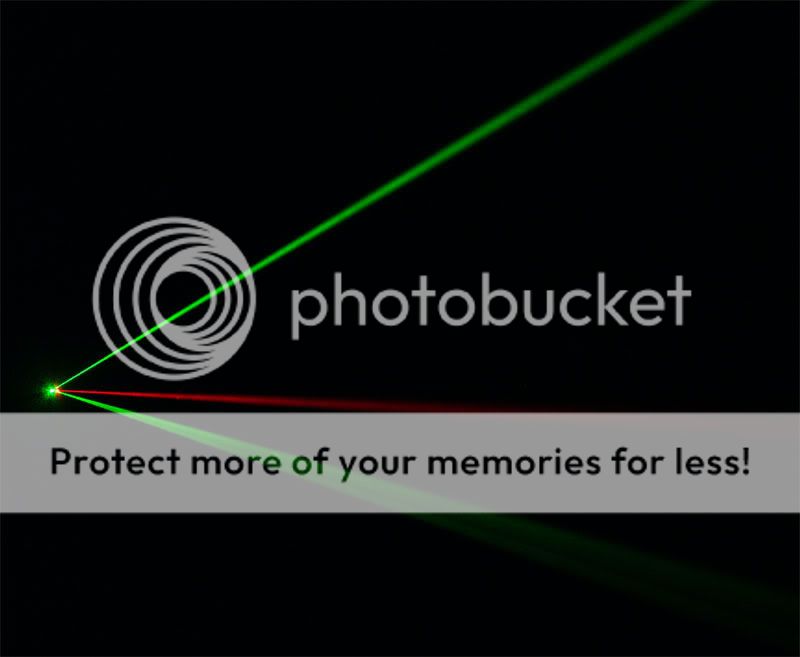uberdaz
Newly Enlightened
Hi all,
This is my first post on this forum, greetings all! I've been a casual reader of this forum for a while but have only recently started to seriously experiment with lasers. I'm a responsible adult in my late 20's who takes safety very seriously and I use all the appropriate precautions.
I have 5 lasers:
1 x 10mW 650nm red
2 x 10mW 532nm green
1 x 20mW 532nm green
1 x 30mW 532nm green
I am a keen astronomer so this was my main motivation for getting in to lasers, the 20mW and 30mW look awesome when used for star pointing - it's literally made finding nebulae, clusters, galaxies etc so easy.
The reason I write this post is that I am wondering if there are any other experienced experimenters out there that can suggest some further things to try out. I've done extensive experimenting with fluorescence, diffraction, refraction, diffusion, reflection, mirrors, beam splitting, photography, forensics etc.
I've had a lot of fun using diffraction gratings to get some great looking shapes and beam configurations, I've cannabalised many, many cd players and cdrom drives much to my wifes displeasure (I usually leave the leftovers scattered throughout my house) to get access to the dielectric mirrors, lenses and gratings.
I've found that using a dichroic mirror cannabalised from what appeared to be some theatrical lighting system is excellent for observing flourescence in objects illuminated by 532nm wavelength. I couldn't believe how many things fluoresce, the glass of scotch sitting in front of me fluoresces a very bright red when I shine my laser through it. The mirror appears to block out wavelength very close to the 532nm allowing me to observe induced light at other wavelengths.
I am curious though, as my recently purchased 30mW is a bit disappointing compared to my 20mW - in fact, the beam itself does not appear as bright from what I can tell (I don't have a laser power meter - this is next on my list), although they are very similar. In fact, the 30mW spot looks ever so slightly more yellow than the 20mW, I'm talking barely perceptable difference, but a difference none the less. The power output seems to fluctuate quite a lot more in the 30mW also.
Can anyone give me advice as to why this would be the case? Am I not warming up the laser enough? What are typical warm up times for these power outputs? Can the wavelength output vary slightly between lasers? Anything else that experienced laser experimenters can suggest? Is there a way to compare the power outputs without using a power meter?
Cheers guys, looking forward to your comments!
This is my first post on this forum, greetings all! I've been a casual reader of this forum for a while but have only recently started to seriously experiment with lasers. I'm a responsible adult in my late 20's who takes safety very seriously and I use all the appropriate precautions.
I have 5 lasers:
1 x 10mW 650nm red
2 x 10mW 532nm green
1 x 20mW 532nm green
1 x 30mW 532nm green
I am a keen astronomer so this was my main motivation for getting in to lasers, the 20mW and 30mW look awesome when used for star pointing - it's literally made finding nebulae, clusters, galaxies etc so easy.
The reason I write this post is that I am wondering if there are any other experienced experimenters out there that can suggest some further things to try out. I've done extensive experimenting with fluorescence, diffraction, refraction, diffusion, reflection, mirrors, beam splitting, photography, forensics etc.
I've had a lot of fun using diffraction gratings to get some great looking shapes and beam configurations, I've cannabalised many, many cd players and cdrom drives much to my wifes displeasure (I usually leave the leftovers scattered throughout my house) to get access to the dielectric mirrors, lenses and gratings.
I've found that using a dichroic mirror cannabalised from what appeared to be some theatrical lighting system is excellent for observing flourescence in objects illuminated by 532nm wavelength. I couldn't believe how many things fluoresce, the glass of scotch sitting in front of me fluoresces a very bright red when I shine my laser through it. The mirror appears to block out wavelength very close to the 532nm allowing me to observe induced light at other wavelengths.
I am curious though, as my recently purchased 30mW is a bit disappointing compared to my 20mW - in fact, the beam itself does not appear as bright from what I can tell (I don't have a laser power meter - this is next on my list), although they are very similar. In fact, the 30mW spot looks ever so slightly more yellow than the 20mW, I'm talking barely perceptable difference, but a difference none the less. The power output seems to fluctuate quite a lot more in the 30mW also.
Can anyone give me advice as to why this would be the case? Am I not warming up the laser enough? What are typical warm up times for these power outputs? Can the wavelength output vary slightly between lasers? Anything else that experienced laser experimenters can suggest? Is there a way to compare the power outputs without using a power meter?
Cheers guys, looking forward to your comments!


